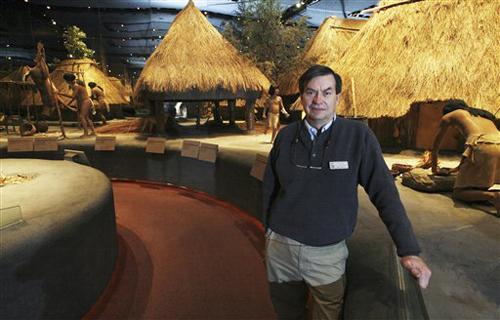Much still to be learned about Cahokian Mounds

Bill Iseminger poses inside the Museum at the Cahokia Mounds Historic Site near Collinsville, Ill., on Jan. 29, 2008. In 1980, Bill Iseminger and other archaeologists drew up a plan to acquire land, build an interpretive center and learn what they could a Derik Holtmann, The Associated Press
April 7, 2008
COLLINSVILLE, Ill. – It’s so much a part of the landscape that metro-east residents often don’t even notice it, except when a visiting relative notices: “Look, there’s the mound.”
Rising from what once was an endless grass sea parted by the Mississippi River, Monks Mound isn’t even named after the Native American Indians who built it centuries ago, but the Trappist monks who lived there for only five years in the 19th century.
No one knows what the long-vanished people who built the mounds called themselves, much less what they named their terraced mound. Archaeologists call them the Mississippians, and their lives continue to be a mystery whose clues are buried in the mounds scattered throughout the metro-east and far beyond.
During the last three decades, the main part of the Cahokia Mounds State Historic Site – what once was “downtown” for the largest prehistoric settlement on the continent – has been dubbed a World Heritage Site and turned into a tourist attraction and center for prehistoric research.
In 1980, Bill Iseminger and other archaeologists drew up a plan to acquire land, build an interpretive center and learn what they could about the people who lived there. In 28 years, Iseminger has seen just about everything on that plan come to pass. Now, as site manager, he is working on a plan for the next three decades.
Get The Daily Illini in your inbox!
The new plan will focus on revamped exhibits and expansion for the interpretive center, helping the public to learn more about Cahokia and provide larger space for temporary exhibits. The site also will continue to add surrounding property as it can afford to do so from willing sellers, Iseminger said. “We’ve got more people approaching us than we have money to spend,” he said.
There have been nearly three decades of research, testing and excavations for Iseminger, who has worked with generations of students and a number of archaeologists summer after summer as they try to find out more about the Mississippians, their culture and what ultimately happened to them.
“It’s the largest archaeological site in America, so it’s kept my interest all these years,” Iseminger said. “There is so much we don’t know, a lot of questions we have about what happened here.”
The earliest campsites at Cahokia have been dated to 700 B.C., but it was nearly 1,400 years later before agriculture and mound-building began. Monks Mound was built over a 300-year period, from 900 to 1200. Woodhenge, a circular calendar built of wooden posts, was first built in 1000, and by 1250, Cahokia was larger than London with 20,000 people.
Julie Holt, chairwoman of the anthropology department at Southern Illinois University Edwardsville, said visiting Cahokia at that time would have been “like going to New York City.” In fact, it would be the early 1800s before another North American city surpassed Cahokia’s population, when Philadelphia reached 20,000 people. The second-largest site, in Alabama, would fit entirely within Cahokia’s “downtown” area.
“There was nothing like it in U.S. history until well past the colonial period,” Holt said. SIUE has sent countless archaeology classes to the site over the decades to assist in the summertime digs on the mounds, the living areas and the path of the palisade wall constructed more than 1,000 years ago.






